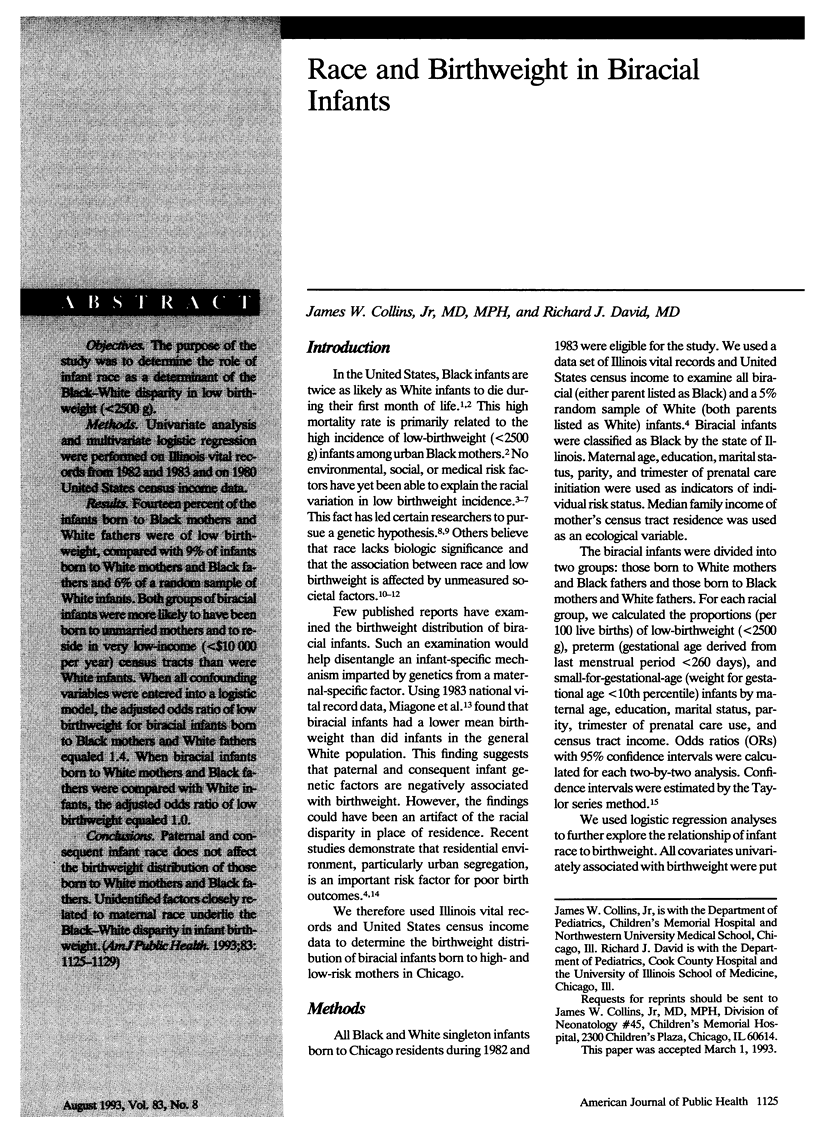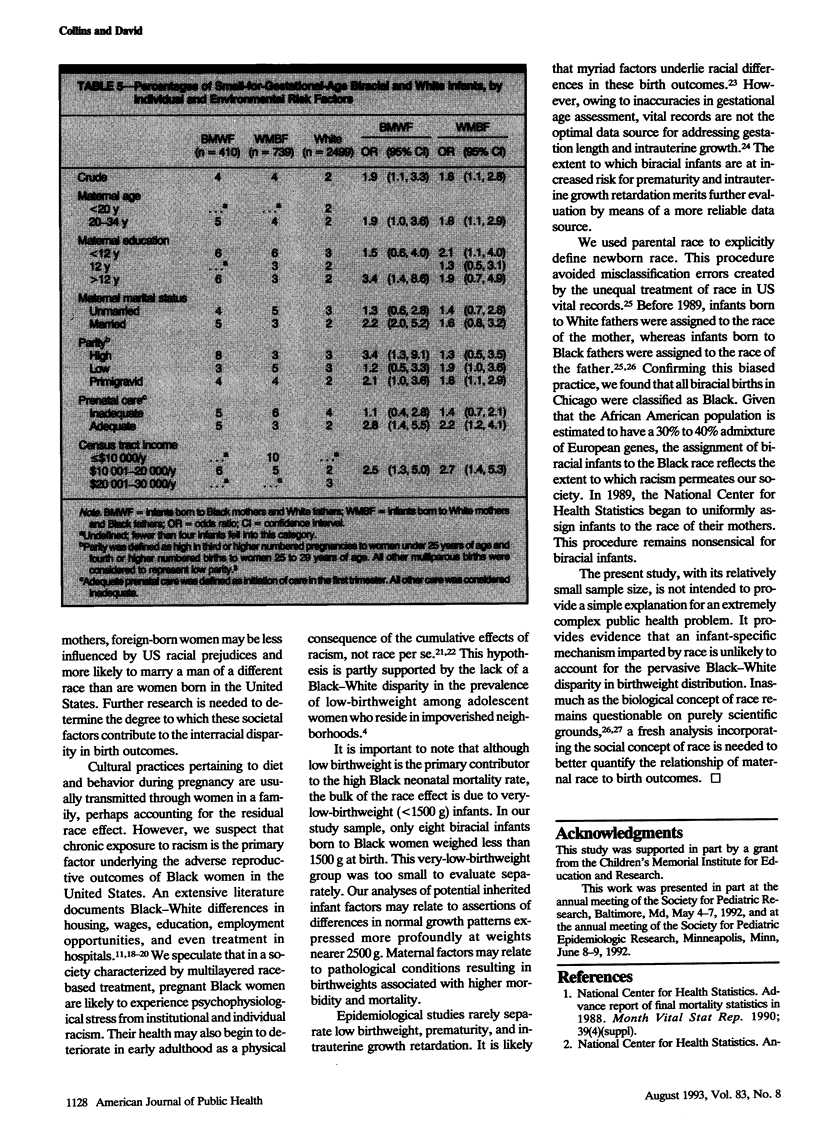Abstract
OBJECTIVES. The purpose of the study was to determine the role of infant race as a determinant of the Black-White disparity in low birthweight (< 2500 g). METHODS. Univariate analysis and multivariate logistic regression were performed on Illinois vital records from 1982 and 1983 and on 1980 United States census income data. RESULTS. Fourteen percent of the infants born to Black mothers and White fathers were of low birthweight, compared with 9% of infants born to White mothers and Black fathers and 6% of a random sample of White infants. Both groups of biracial infants were more likely to have been born to unmarried mothers and to reside in very low-income (< $10,000 per year) census tracts than were White infants. When all confounding variables were entered into a logistic model, the adjusted odds ratio of low birthweight for biracial infants born to Black mothers and White fathers equaled 1.4. When biracial infants born to White mothers and Black fathers were compared with White infants, the adjusted odds ratio of low birthweight equaled 1.0. CONCLUSIONS. Paternal and consequent infant race does not affect the birthweight distribution of those born to White mothers and Black fathers. Unidentified factors closely related to maternal race underlie the Black-White disparity in infant birthweight.
Full text
PDF




Selected References
These references are in PubMed. This may not be the complete list of references from this article.
- Collins J. W., Jr, David R. J. The differential effect of traditional risk factors on infant birthweight among blacks and whites in Chicago. Am J Public Health. 1990 Jun;80(6):679–681. doi: 10.2105/ajph.80.6.679. [DOI] [PMC free article] [PubMed] [Google Scholar]
- Cooper R., David R. The biological concept of race and its application to public health and epidemiology. J Health Polit Policy Law. 1986 Spring;11(1):97–116. doi: 10.1215/03616878-11-1-97. [DOI] [PubMed] [Google Scholar]
- David R. J., Collins J. W., Jr Bad outcomes in black babies: race or racism? Ethn Dis. 1991 Summer;1(3):236–244. [PubMed] [Google Scholar]
- David R. J. The quality and completeness of birthweight and gestational age data in computerized birth files. Am J Public Health. 1980 Sep;70(9):964–973. doi: 10.2105/ajph.70.9.964. [DOI] [PMC free article] [PubMed] [Google Scholar]
- Geronimus A. T., Hillemeier M. M. Patterns of blood lead levels in US black and white women of childbearing age. Ethn Dis. 1992 Summer;2(3):222–231. [PubMed] [Google Scholar]
- Geronimus A. T. The weathering hypothesis and the health of African-American women and infants: evidence and speculations. Ethn Dis. 1992 Summer;2(3):207–221. [PubMed] [Google Scholar]
- Hahn R. A. The state of federal health statistics on racial and ethnic groups. JAMA. 1992 Jan 8;267(2):268–271. [PubMed] [Google Scholar]
- Johnstone F., Inglis L. Familial trends in low birth weight. Br Med J. 1974 Sep 14;3(5932):659–661. doi: 10.1136/bmj.3.5932.659. [DOI] [PMC free article] [PubMed] [Google Scholar]
- Khoury M. J., Cohen B. H. Genetic heterogeneity of prematurity and intrauterine growth retardation: clues from the Old Order Amish. Am J Obstet Gynecol. 1987 Aug;157(2):400–410. doi: 10.1016/s0002-9378(87)80181-3. [DOI] [PubMed] [Google Scholar]
- Klebanoff M. A., Shiono P. H., Berendes H. W., Rhoads G. G. Facts and artifacts about anemia and preterm delivery. JAMA. 1989 Jul 28;262(4):511–515. [PubMed] [Google Scholar]
- Murray J. L., Bernfield M. The differential effect of prenatal care on the incidence of low birth weight among blacks and whites in a prepaid health care plan. N Engl J Med. 1988 Nov 24;319(21):1385–1391. doi: 10.1056/NEJM198811243192105. [DOI] [PubMed] [Google Scholar]
- Polednak A. P. Black-white differences in infant mortality in 38 standard metropolitan statistical areas. Am J Public Health. 1991 Nov;81(11):1480–1482. doi: 10.2105/ajph.81.11.1480. [DOI] [PMC free article] [PubMed] [Google Scholar]
- Schoendorf K. C., Hogue C. J., Kleinman J. C., Rowley D. Mortality among infants of black as compared with white college-educated parents. N Engl J Med. 1992 Jun 4;326(23):1522–1526. doi: 10.1056/NEJM199206043262303. [DOI] [PubMed] [Google Scholar]
- Wenneker M. B., Epstein A. M. Racial inequalities in the use of procedures for patients with ischemic heart disease in Massachusetts. JAMA. 1989 Jan 13;261(2):253–257. [PubMed] [Google Scholar]
- Wildschut H. I., Lumey L. H., Lunt P. W. Is preterm delivery genetically determined? Paediatr Perinat Epidemiol. 1991 Oct;5(4):363–372. doi: 10.1111/j.1365-3016.1991.tb00722.x. [DOI] [PubMed] [Google Scholar]
- Wise P. H., Pursley D. M. Infant mortality as a social mirror. N Engl J Med. 1992 Jun 4;326(23):1558–1560. doi: 10.1056/NEJM199206043262309. [DOI] [PubMed] [Google Scholar]
- Yip R., Li Z., Chong W. H. Race and birth weight: the Chinese example. Pediatrics. 1991 May;87(5):688–693. [PubMed] [Google Scholar]


